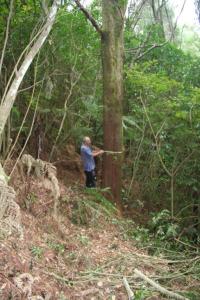Blackwood – the start of a learning curve
by Ian Brown
For over 30 years I have been on a learning curve for blackwood. I planted my first blackwoods in 1980 on a small abandoned farm property I had bought in the far north of New Zealand. It was a long way from home, but it was cheap, and the nearby coast was appealing for family holidays. It was located in an elevated valley, sheltered from prevailing winds, an adjacent range provided good rainfall, and had clay loam soils based on ancient volcanics. In response to a recent study carried out by Ian Nicholas at Forest Research, who had been working on a project to select a limited number of species to supplement our monoculture of radiata pine, my brother and I decided to trial some alternative species, including blackwood.
Blackwoods have been planted in New Zealand from the 19th century. It had been generally assumed that to produce good form they should be interplanted with another species, and many had been planted in native bush, or in mixtures with eucalypts or pines. There had been little interest in pruning blackwood for form correction.
1980 trial planting.
We planted 500 blackwoods in groups of 4 trees, 8 metres between groups, and interplanted with pines. When we visited the site in the first summer the blackwoods were growing strongly, and were about chest height, but some of them were developing double leaders and competing branches. It seemed logical to trim these back, leaving a single leading shoot. Without a clear agenda, we set to with secateurs. However competing demands for time (fishing) meant we did not finish the job. In the following summer, two things were apparent: the trees we had pruned were much better in form than the unpruned trees, and the pruning had not affected their growth rate. And the blackwoods were growing faster than the pines, which were clearly having no influence on them. Over each of the following summers we continued with form pruning, directing attention to competing shoots near the top of the trees, and from about year 4 followed through with clearwood pruning from the base. When the trees were above 6 metres we thinned them to one per group.
The pines lagged behind, and made no contribution until about year 4, and by year 6 were suppressing the blackwoods. We then felled the pines. This left a thick layer of slash, which made access difficult for further silvicultural work. The pines had clearly been more trouble than they were worth.
I have a trial plot on the site, and in 2010 at age 30 the mean diameter was 55 cm. It should be close to 60 cm by 35 years, when I hope to mill them.
The message we got from this block was that on a good site, blackwoods respond well to annual form pruning, without the need for a nurse. So we decided to try something novel.
1982. Open grown planting.
In 1982 we planted blackwoods, again in groups at 7 to 8 metre spacing between groups, in the open, and undertook annual form pruning, but without a nurse species. These are probably the first blackwoods to have had this form of intensive annual treatment. Of the systems we have tried, it proved to be the simplest and most effective, and with some modifications it has been the method I have used since then.
At the same time we planted blackwoods in holes cut in an area of regenerating native scrub. This worked well, but the trees still needed an annual visit for light form pruning and remove overhanging branches. I tended to get lost when locating the trees, and spent some time wandering about in circles. This might have been avoided by cutting lines in the scrub.
1983. Blackwoods and eucalypts.
In 1983 we returned to orthodox management, and interplanted blackwoods in a mixture with with E. saligna. This worked well for the first few years, and we started to clearfell the eucalypts at about year 5. Half way through the program we encountered a problem familiar to growers who have tried this regime: we were seduced by the eucs, which were growing strongly, and looked too good to fell. So we kept them, in the hope of eventually milling both species. It didn’t work out. The blackwoods became badly suppressed, and the eucalypts thrived. Where we had thinned the eucs, the blackwoods grew well.
The message here was that nurse species provide some benefit for a limited period, but although improving form, they do not eliminate the need for form pruning. They add costs and complicate the management, and to avoid suppression have to be sacrificed on time.
In subsequent planting in the Waikato I have relied on form pruning on open-grown trees, planted in groups of 3 or 4 at final spacing. This has worked well, and has done so on other plantations in NZ that I have looked at, provided one essential condition is met: to grow blackwoods in the open and without a nurse you must have a good site, one that will encourage rapid growth. This means warmth, shelter, adequate moisture, and decent soils. On sites that are cold, dry or exposed, it is very difficult to control form in open grown trees. In those conditions you might get away with it by using a nurse crop. Or it might be better to simply plant another species.
Photos are from the Northland planting, taken in April 2010. The top photo is from the 1980 planting. The scrub is natural regeneration. The tree marked 7 (below) is from the 1982 planting, open planted and annually form pruned DBH 70 cm at age 28. Naturally it is one of the bigger trees.
Thanks Ian for a great contribution. I hope it generates some discussion amongst readers.


